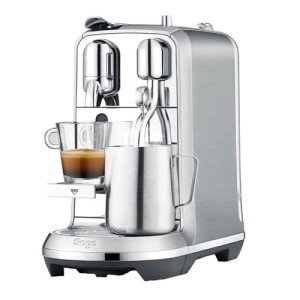Heat Exchange Espresso Machines: A Comprehensive Guide
Espresso machines have progressed substantially over the years, dealing with the needs of home baristas and coffee specialists alike. Among these machines, heat exchange espresso machines have actually acquired appeal due to their ability to provide constant performance and extraordinary brew quality. In Manual Espresso Machines , we will check out the operations, advantages, and crucial functions of heat exchange espresso machines, offering a detailed understanding for both possible buyers and coffee lovers.
Understanding Heat Exchange Technology
Heat exchange espresso machines operate on a special principle that permits simultaneous water heating for developing and steaming. They are equipped with a single boiler that uses a heat exchanger system. This feature is considerable as it allows users to brew espresso while steaming milk simultaneously, promoting effectiveness in the coffee-making procedure.
How Does a Heat Exchange Espresso Machine Work?
The process starts with the machine's water inlet filling the boiler. As Pod Espresso Machines warms up, it turns to steam. The ingenious heat exchanger uses hot steam to heat additional water in a separate passage developed specifically for the brew group. This means that water can reach the perfect brewing temperature level without awaiting the boiler to adjust. The key actions consist of:
- Water Fill: Water is drawn into the boiler.
- Heating Process: The boiler heats up as water is converted into steam.
- Heat Exchange: Steam heats up water in the heat exchanger tube.
- Brewing: Water from the heat exchanger is pressed through coffee premises, drawing out the flavors required for an abundant espresso.
This procedure enables quick temperature modifications and enhanced coffee extraction.
Benefits of Heat Exchange Espresso Machines
Heat exchange espresso machines offer numerous advantages, especially for those aiming to maximize their coffee experience. Here are some key advantages:
- Simultaneous Brewing and Steaming: Users can brew espresso while steaming milk, making it perfect for busy coffee shops and home baristas who value performance.
- Temperature Stability: The boiler's steam pressure assists preserve a stable temperature level, which is important for consistent espresso extraction.
- Versatility: The design enables quick changing in between developing and steaming, making it simpler to produce different coffee beverages, from lattes to coffees.
- User-friendly: Models typically come with accessible controls, making it possible for both novices and knowledgeable baristas to produce quality beverages.
- Professional Quality: Heat exchange machines are typically used in commercial settings, providing users with high-quality developing efficiency in the house.
Secret Features to Look for in Heat Exchange Espresso Machines
When thinking about the purchase of a heat exchange espresso machine, there are several features that one must consider:
- Build Quality: Look for machines made from long lasting materials, such as stainless steel or brass, ensuring longevity.
- Boiler Size: A larger boiler will hold more water and sustain higher output in time.
- PID Temperature Control: This feature helps preserve consistent brew temperature levels, which can boost the coffee-making process.
- Group Head Design: Machines with a saturated or semi-saturated group head offer much better temperature level stability.
- Reduce of Use: User-friendly user interfaces and user-friendly controls improve the general experience for baristas at all skill levels.
- Steam Wand Quality: A good steam wand with proper insulation and versatility enables much better texturing of milk.
- Water Reservoir Size: Depending on your requirements, consider how typically you wish to refill the water reservoir.
Comparison of Popular Heat Exchange Espresso Machines
To much better understand the choices offered in the market, listed below is a contrast table of some popular heat exchange espresso machines:
| Machine Model | Boiler Size | PID Control | Rate Range | User Ratings |
|---|---|---|---|---|
| Profitec Pro 700 | 2.0 L | Yes | ₤ 2,000-₤ 2,500 | 9.5/ 10 |
| Rocket Espresso R58 | 1.8 L | Yes | ₤ 2,400-₤ 2,800 | 9.4/ 10 |
| Elekta Bianca | 1.8 L | Yes | ₤ 2,500-₤ 3,000 | 9.6/ 10 |
| La Spaziale S1 Vivaldi II | 1.5 L | Yes | ₤ 1,800-₤ 2,200 | 9.2/ 10 |
| Bezzera Magica | 1.2 L | No | ₤ 1,600-₤ 1,800 | 9.0/ 10 |
FAQs About Heat Exchange Espresso Machines
What is the main distinction in between a heat exchange and a dual boiler espresso machine?
While both types can brew espresso and steam milk at the exact same time, dual boiler machines have different boilers for developing and steaming. On the other hand, heat exchange machines make use of a single boiler and a heat exchanger to accomplish the exact same function.
Are heat exchange machines suitable for novices?
Yes! Many heat exchange machines are developed with easy to use features, making them accessible for beginners. With appropriate assistance and practice, users can quickly produce quality espresso.
What sort of maintenance do heat exchange espresso machines need?
Routine maintenance consists of descaling, cleaning up the boiler, inspecting seals and gaskets, and keeping the group head clean. Routine upkeep makes sure longevity and constant efficiency.
Can I use a heat exchange machine for various types of coffee drinks?
Definitely! Heat exchange machines enable users to create a variety of coffee drinks, including espresso, lattes, coffees, and more.
Heat exchange espresso machines represent a mix of development and tradition, offering coffee enthusiasts with the tools needed for crafting the ideal cup. Their capability to simultaneously brew and steam, integrated with accurate temperature control, makes them a compelling option for both home baristas and professionals. With the right knowledge on functions and upkeep, users can open a world of elegant coffee experiences, guaranteeing that each sip is as delightful as the last.

